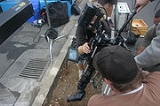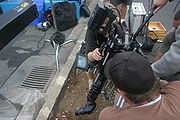
Frazier lens
Encyclopedia

Jim Frazier
Jim Frazier is an Australian inventor, naturalist and cinematographer who invented the Panavision-Frazier lens. He has won many Australian and international awards for his work, including an Academy Award for Technical Achievement and an Emmy Award...
. The Frazier lens provides a massive depth of field
Depth of field
In optics, particularly as it relates to film and photography, depth of field is the distance between the nearest and farthest objects in a scene that appear acceptably sharp in an image...
, allowing the foreground and background of an image to be in focus
Focus (optics)
In geometrical optics, a focus, also called an image point, is the point where light rays originating from a point on the object converge. Although the focus is conceptually a point, physically the focus has a spatial extent, called the blur circle. This non-ideal focusing may be caused by...
. Frazier's lenses have been widely used in Hollywood and wildlife cinematography. In addition to its unique depth of field properties, the Frazier lens is significantly smaller than previous deep focus lenses allowing more versatility and flexibility to cinematographers. The main feature of the lens, an extended tube with a rotating prism, allows cinematographers to place the camera in a variety of positions for a given shot. Cinematographers then rotate the prism to correct the horizon. This feature allows directors and cameramen to achieve shots in minutes that previously took cinematographers hours in rigging and designing special sets to accommodate shooting positions.
Patent Claims
A United States patent 5,727,236 was issued on March 10, 1998 for the lens and the Academy of Motion Picture Arts and SciencesAcademy of Motion Picture Arts and Sciences
The Academy of Motion Picture Arts and Sciences is a professional honorary organization dedicated to the advancement of the arts and sciences of motion pictures...
awarded a Technical Achievement Award to Frazier for his lenses. The patent was licensed to Panavision for production and marketing of the lens. In 2003, Panavision and Frazier brought suit against Roessel Cine Photo Tech, Inc. for violating the patent.
At the trial, it was discovered that the video Frazier had submitted ("[i]n the interests of demonstrating to the Examiner the features and uniqueness of the optical system of this patent application") shots that had been created with a different lens.
The patent was declared unenforceable for inequitable conduct
Inequitable conduct
In United States patent law, inequitable conduct is a defense to allegations of patent infringement. Even in the instance that a patent is valid and infringed, the court ruling on infringement may exercise its equitable discretion not to enforce the patent if the patentee has engaged in inequitable...
and attorney's fees were awarded to the defendants.
External links
- Frazier Lens US Patent 5,727,236 PDF at Google Patents
- Official page with pictures at panavision.com
- "Australian invention dazzles Hollywood" at wipo.int
- Informal message board talk about the lens at cinematography.net
- Inequitable Depth of Field - Frazier lens
- US Federal Appeal Court Decision - Frazier vs. Roessel Cine Photo

